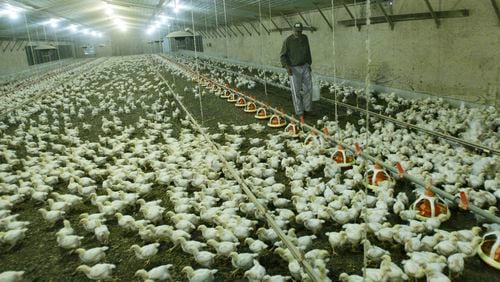Georgia agriculture officials are investigating the state’s influential process for setting chicken prices after questions have been raised about its accuracy.
State Agriculture Commissioner Gary Black said his staff wants to make sure the department-issued Poultry Market News Bulletin properly reflects the price of chicken, and the state is taking steps to better examine and verify the data it receives from producers to establish prices.
Known as the “Georgia Dock,” the weekly bulletin affects the price of chicken in supermarkets and restaurants across the country. As the nation’s largest producer of broiler chickens, Georgia’s bulletin can impact billions of dollars in poultry sales a week.
But now, many inside the industry and in Washington are questioning the precision of the Georgia Dock. Questions about how the bulletin is produced and the information it uses to calculate market prices have been raised for months, since The Wall Street Journal reported in January that the Georgia index was showing prices up to 60 percent higher than other indexes.
It’s a difference between, for example, $1.13 per pound and 70 cents per pound. That may not seem like much, but when you consider that Georgia, the country’s largest grower of broilers, also known as whole fryer chickens, produces an average of 29.3 million pounds of chicken every day, the difference could mean billions of dollars a week.
The Georgia Dock is “a trusted source for price discovery for the contract market,” Black said in an interview. “Nothing has changed about that. And our commitment to making sure its integrity is maintained — we’re committed to that.”
The index is created weekly when a Department of Agriculture employee contacts eight poultry companies in the state and asks how many and what kind of chickens they sold that week and at what price. The names of the eight companies are kept secret by state law, and there is no independent verification of what sales figures the companies report.
State officials note, however, that there are safeguards to prevent one company from inflating its prices in an attempt to artificially increase the index. Any company that reports a price more than 1 cent above or below the average price is dropped from that week’s report.
Yet, the veracity of the companies’ submissions to the index were further questioned in a memo written in September by Arty Schronce, a veteran Department of Agriculture employee who calls the companies each week. The data he compiles is then plugged into an algorithm to set the price. Schronce uses a complicated formula that gives more weight to top producers, meaning the larger the company, the more impact its price has on the final price used in the index.
"I continue to have concerns about the Poultry Market News," Schronce wrote in the memo, which was first reported by The Washington Post. "I voiced concerns in the past. However, I think it is time to re-evaluate and examine PMN and consider eliminating it. I see it as a flawed product that is a liability to the Georgia Department of Agriculture."
Black said the same system has been in place for 40 years and that it’s the same system used by other states and the federal government to set prices for many products. Grocery store chains, restaurants and other businesses use the index when buying commodities from wholesalers. By some estimates, the Georgia Dock is used to set prices for 10 percent to 15 percent of all chicken sold in the United States.
This summer, however, the U.S. Department of Agriculture stopped including the Georgia Dock in its weekly report of commodity prices when the state declined to provide independent verification of the index, The New York Times reported. Black said the federal agency made its decision without discussing it with him. He said the USDA continues to list other chicken indexes but that there are significant differences between those and the Georgia Dock.
Georgia’s, Black said, are used for contracts while the other indexes are used for spot-market purchases. Contracts account for up to 90 percent of all chicken sold in the U.S., he said, because they offer stability, allowing grocers to know how much their costs are for the length of the agreements. Spot-market purchases are subject to daily impacts, such as a spike in costs for feed, fuel or ice.
Still, Black said, the state is preparing what it hopes is a solution. His department this week will begin asking companies participating in the index to sign an affidavit that allows the state to review and audit the figures the companies report.
“That’s an appropriate step,” Black said.
Georgia’s chicken market is dominated by several major companies, including Pilgrim’s Pride and Tyson Foods.
“We’re considering the request from the state of Georgia,” Tyson spokesman Worth Sparkman said. “We continue to contribute information for the Georgia Dock. As we’ve previously said, when the Georgia Department of Agriculture asks us for pricing data, we provide accurate information based on actual and recent transactions. We do not see the prices reported by our competitors to the state.”
Sparkman said only 3 percent to 4 percent of Tyson’s contracts use the Georgia Dock.
Pilgrim’s Pride spokesman Cameron Bruett said only 5 percent of its sales are based on the Georgia Dock.
Mike Giles, the president of the Georgia Poultry Federation, a private trade industry group, said the Georgia Dock has been trusted for decades.
“And over that time period it has been used voluntarily by some buyers and sellers as a useful tool in negotiations to reach a selling price that is agreeable to both parties,” Giles said. “Of course, we don’t see individual company information submitted, but I have confidence that the Poultry Market News publishes credible information that is useful for buyers and sellers during these negotiations.”







